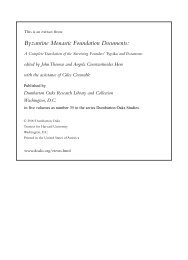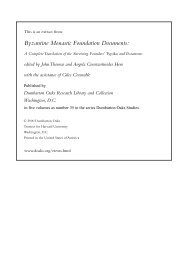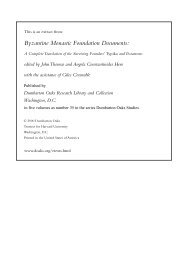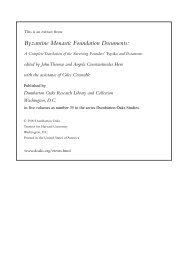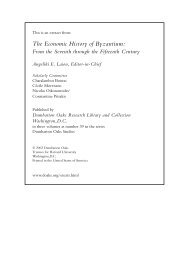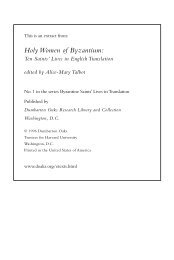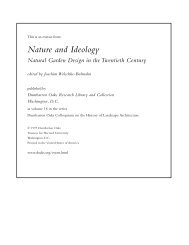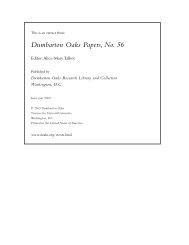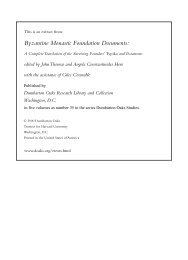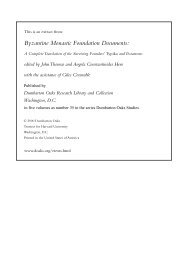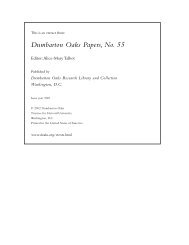Changing Economic Patterns in Latin Romania - Dumbarton Oaks
Changing Economic Patterns in Latin Romania - Dumbarton Oaks
Changing Economic Patterns in Latin Romania - Dumbarton Oaks
You also want an ePaper? Increase the reach of your titles
YUMPU automatically turns print PDFs into web optimized ePapers that Google loves.
<strong>Chang<strong>in</strong>g</strong> <strong>Economic</strong> <strong>Patterns</strong> <strong>in</strong> Lat<strong>in</strong> <strong>Romania</strong>:<br />
The Impact of the West<br />
David Jacoby<br />
The dramatic fall of Constant<strong>in</strong>ople <strong>in</strong> 1204 and the Lat<strong>in</strong> conquest of the empire’s<br />
prov<strong>in</strong>ces <strong>in</strong> the follow<strong>in</strong>g decade resulted <strong>in</strong> the dismemberment of <strong>Romania</strong>. The<br />
Lat<strong>in</strong>s established a fairly large number of new political entities <strong>in</strong> the region, most of<br />
which rema<strong>in</strong>ed under their rule for more than two centuries. These long-term political<br />
and territorial developments also generated profound economic changes. 1 The present<br />
survey is not aimed at provid<strong>in</strong>g an overall picture of the complex economic evolution<br />
of Lat<strong>in</strong> <strong>Romania</strong> until around the mid-fifteenth century. Rather, it attempts to determ<strong>in</strong>e,<br />
as far as possible, the nature, extent, and pace of the Western impact on some of<br />
its aspects and trends. To this effect, it will be necessary time and aga<strong>in</strong> to look back at<br />
conditions and patterns exist<strong>in</strong>g before the Fourth Crusade.<br />
It would be tedious to review the complex history of the political entities created by<br />
the Lat<strong>in</strong>s on Byzant<strong>in</strong>e soil after 1204. However, two of them warrant our attention,<br />
s<strong>in</strong>ce they were of particular importance for the economic evolution of Lat<strong>in</strong> <strong>Romania</strong><br />
and happen to be fairly well documented: the Venetian maritime empire and the<br />
Frankish pr<strong>in</strong>cipality of the Morea <strong>in</strong> the Peloponnesos. Venice laid the foundations of<br />
its centralized maritime empire <strong>in</strong> 1207, when it began the conquest of Crete and occupied<br />
Coron and Modon, two ports of southern Messenia. In 1211 it obta<strong>in</strong>ed a quarter<br />
<strong>in</strong> the ma<strong>in</strong> city of Euboea, Euripos, called Negroponte by the Lat<strong>in</strong>s, a name also used<br />
for the island itself. The second stage of Venetian expansion <strong>in</strong> <strong>Romania</strong> took place <strong>in</strong><br />
the 1380s and 1390s, when Venice extended its dom<strong>in</strong>ation over the island of Corfu,<br />
the whole of Euboea, and several cities and lordships <strong>in</strong> the Peloponnesos and the Aegean.<br />
2 The pr<strong>in</strong>cipality of the Morea was the largest among the lordships created <strong>in</strong> non-<br />
1 I shall not deal here with the short-lived K<strong>in</strong>gdom of Thessalonica and Lat<strong>in</strong> Empire of Constant<strong>in</strong>ople,<br />
nor with the few islands of the Aegean occupied by the Genoese <strong>in</strong> the 14th century. They differed markedly<br />
from most territories of Lat<strong>in</strong> <strong>Romania</strong> <strong>in</strong> their economic evolution.<br />
2 General historical background and detailed treatment of various issues by S. Borsari, Il dom<strong>in</strong>io veneziano a<br />
Creta nel XIII secolo (Naples, 1963); idem, Studi sulle colonie veneziane <strong>in</strong> <strong>Romania</strong> nel XIII secolo (Naples, 1966);<br />
F. Thiriet, La Romanie vénitienne au Moyen Age: Le développement et l’exploitation du doma<strong>in</strong>e colonial vénitien (XIIe–<br />
XVe siècles), Bibliothèque des Ecoles françaises d’Athènes et de Rome 193, 2d ed. (Paris, 1975); D. Jacoby, La<br />
féodalité en Grèce médiévale: Les “Assises de Romanie.” Sources, application et diffusion (Paris–The Hague, 1971), 185–<br />
308; J. Koder, Negroponte: Untersuchungen zur Topographie und Siedlungsgeschichte der Insel Euboia während der Zeit<br />
der Venezianerherrschaft, Österreichische Akademie der Wissenschaften, Philosophisch-historische Klasse,<br />
Denkschriften 112(Vienna, 1973); short survey by P. Lock, The Franks <strong>in</strong> the Aegean, 1204–1500 (London–




